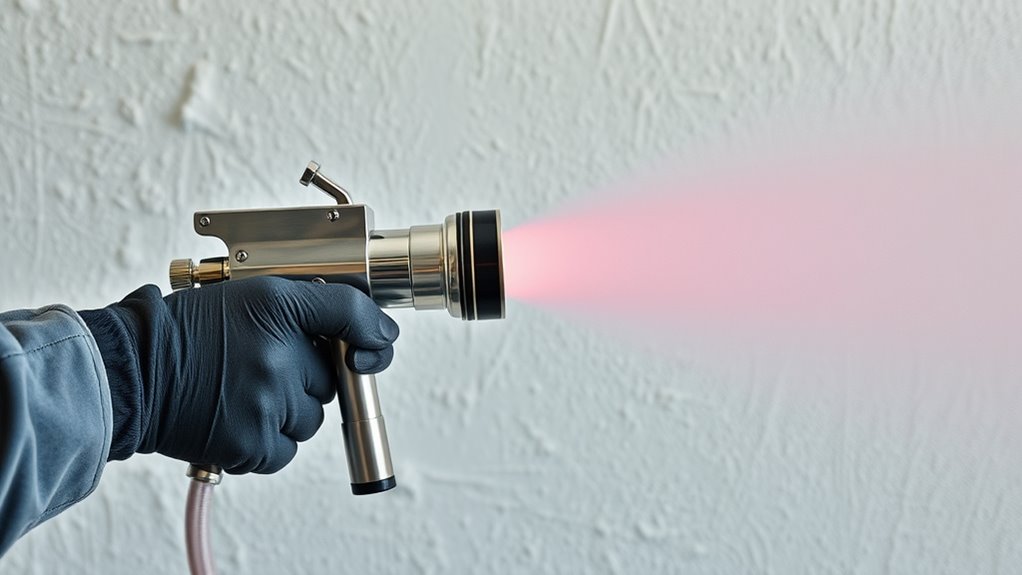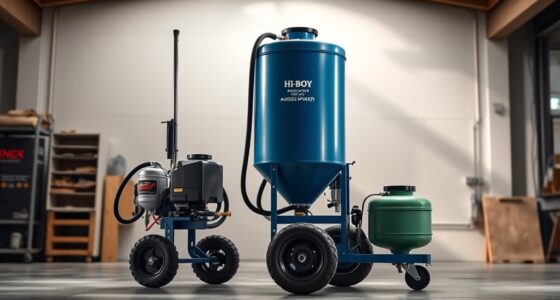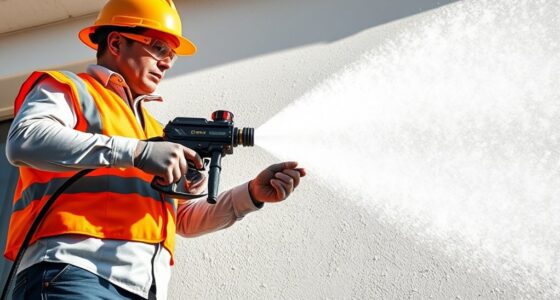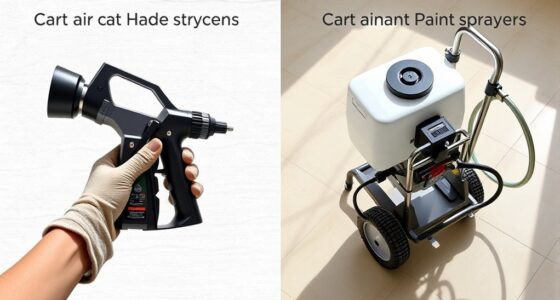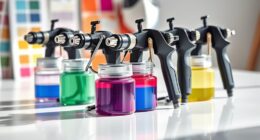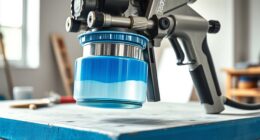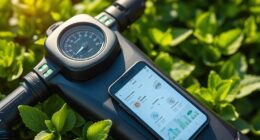Two-component spraying isn’t strictly limited to airless systems, but it does require specialized equipment. While traditional airless sprayers handle single-component coatings, two-component applications need dual-feed or proportioning equipment to mix resin and hardener just before spraying. This guarantees proper chemical reaction and curing. Using the right setup improves application speed, adhesion, and durability. If you’re interested, you’ll discover more about the equipment options and best practices for successful two-component coating applications.
Key Takeaways
- Two-component spraying involves mixing resin and hardener immediately before application for durable coatings.
- It can be adapted for airless systems using specialized dual-feed or proportioning equipment.
- Proper equipment ensures accurate mixing ratios, critical for coating performance and curing.
- Not all airless sprayers are suitable; dedicated plural-component sprayers are preferred for two-component coatings.
- When correctly equipped, two-component spraying integrates seamlessly with airless techniques for high-quality finishes.
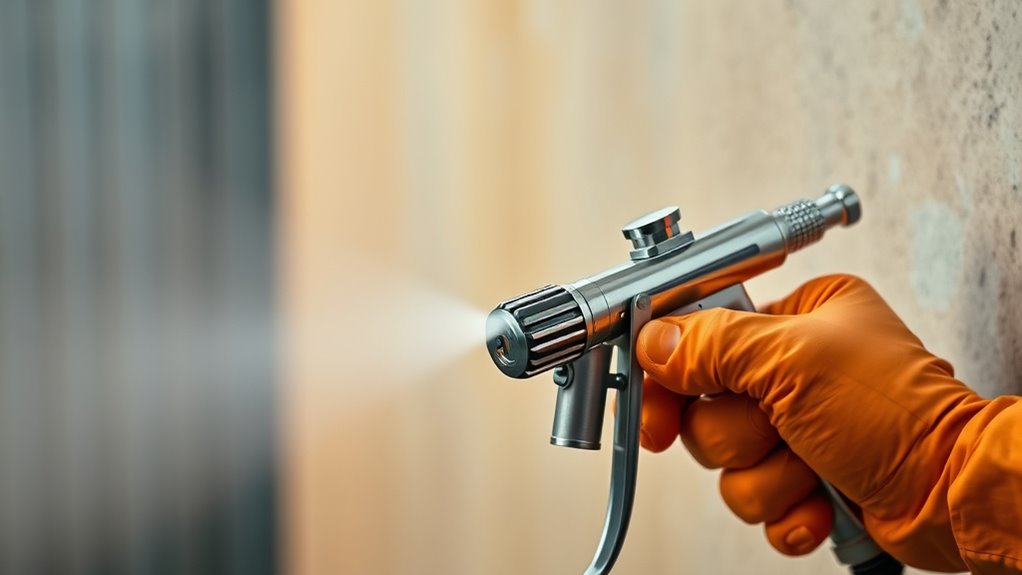
Two-component spraying is a versatile and efficient method for applying coatings, requiring the simultaneous mixing of two different materials just before spraying. This technique is widely used in industries where durability, chemical resistance, and high-performance finishes are essential. When you decide to use a two-component system, you’re engaging in a process that offers superior adhesion, toughness, and overall quality compared to single-component applications. The core idea is straightforward: you combine a resin and a hardener in precise proportions, then spray the mixture onto your surface. The chemical reaction that occurs after mixing creates a solid, durable coating that bonds well with the substrate. This method is especially beneficial in demanding environments like industrial equipment, automotive parts, or protective coatings on infrastructure. Using an appropriate mixing and application system is crucial to ensure consistent results and optimal curing.
You might wonder if two-component spraying fits into the airless spraying domain. The answer is yes, but with some distinctions. Traditional airless sprayers are designed to handle single-component coatings, pushing paint or other materials through a high-pressure nozzle. When it comes to two-component coatings, you need a specialized system that can mix the components accurately and deliver the mixture consistently. Many airless sprayers can be adapted with dual-feed or proportioning equipment, allowing for on-the-fly mixing of resin and hardener. This setup ensures the components are combined just before spraying, which is essential because the chemical reaction begins immediately after mixing, limiting the pot life.
Using an airless system for two-component spraying offers advantages like fast application speed, high atomization quality, and the ability to cover large areas efficiently. However, it also demands precise equipment calibration to maintain the correct ratio of materials throughout the process. If the mixture is off, you risk compromised adhesion, improper curing, or weakened coating properties. That’s why investing in proper proportioners or dual-feed systems is critical. These devices automatically meter the components, reducing human error and ensuring consistent results.
Additionally, understanding the properties of the materials being used, such as their chemical composition and reactivity, is vital for successful application. While airless spraying can be adapted for two-component coatings, not all systems are suitable, and choosing the right equipment is key. Some professionals prefer dedicated plural-component sprayers, which are specifically designed for this purpose. These systems tend to be more accurate and reliable for complex or high-volume applications. Overall, if you’re contemplating whether two-component spraying belongs in your toolkit, remember that with the right equipment, it can be seamlessly integrated into an airless spraying operation. It offers a powerful option for achieving high-quality, durable finishes in demanding applications, making it a valuable technique for professionals who need consistent, high-performance coatings delivered efficiently.
Frequently Asked Questions
Can Two-Component Spraying Be Used for Outdoor Applications?
Yes, you can use two-component spraying for outdoor applications. It’s ideal for projects needing durable, weather-resistant finishes, like fences, decks, or siding. Just make certain you choose the right materials and equipment suited for outdoor conditions. Prep the surface properly, and work in suitable weather to avoid issues like uneven curing or paint failure. With proper technique, two-component spraying provides a smooth, professional finish that withstands the elements.
What Safety Precautions Are Necessary for Two-Component Spraying?
Safety first, because safety’s no accident. You should wear proper personal protective equipment like gloves, goggles, and a respirator to prevent exposure to harmful chemicals. Make certain of good ventilation to avoid inhaling fumes and keep the area well-ventilated. Follow manufacturer instructions for handling and mixing, and avoid skin contact. Regularly inspect equipment for leaks or damage, and clean up spills immediately to protect yourself and others.
How Long Does the Mixed Material Stay Usable?
The mixed material typically stays usable for about 8 to 24 hours, depending on the specific components and environmental conditions like temperature and humidity. To guarantee ideal results, you should always check the manufacturer’s instructions for the exact pot life. Keep the mixture well-mixed, and store it in a sealed container if you plan to use it later within the recommended time frame.
Is Two-Component Spraying Suitable for Small-Scale Projects?
Yes, two-component spraying works well for small-scale projects. You’ll appreciate its precision, quick setup, and smooth finish, making it ideal for detailed tasks or limited areas. You get control over the mix ratio, enabling you to handle delicate surfaces effectively. While it requires some equipment, its efficiency and quality make it a smart choice for smaller jobs, ensuring professional results without the hassle of larger spray systems.
What Are the Cleaning Requirements After Spraying?
After spraying, you need to clean your equipment thoroughly to prevent clogging and guarantee longevity. Immediately flush the spray gun, hoses, and nozzles with the appropriate solvent, usually water or solvent based on the material used. Disassemble parts for detailed cleaning if necessary, and wipe down the exterior. Proper cleaning helps maintain peak performance and avoids cross-contamination for your next project.
Conclusion
Now that you understand the basics, you’re ready to explore two-component spraying. Think of it like steering a new city—challenging at first, but rewarding once you get the hang of it. Whether you choose airless or other methods, mastering this technique will give you a professional finish. With practice, you’ll handle it smoothly, like a skilled musician plays a complex piece. Embrace the learning curve, and you’ll soon create flawless coatings every time.
